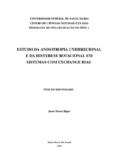| dc.creator | Rigue, Josué Neroti | |
| dc.date.accessioned | 2017-05-09 | |
| dc.date.available | 2017-05-09 | |
| dc.date.issued | 2014-08-18 | |
| dc.identifier.citation | RIGUE, Josué Neroti. Study of unidirectional anisotropy and rotational hysteresis in exchange bias systems. 2014. 152 f. Tese (Doutorado em Física) - Universidade Federal de Santa Maria, Santa Maria, 2014. | por |
| dc.identifier.uri | http://repositorio.ufsm.br/handle/1/3924 | |
| dc.description.abstract | The exchange bias (EB) phenomen occurs due to the coupling between ferromagnetic and
antiferromagnetic material and the main characteristics are the rise of unidirectional anisotropy
and the rotational hysteresis in torque curves.
In this work we have investigated how the unidirectional anisotropy and the rotational hysteresis
are influenced by the change of some characteristics in thin films samples. Among these
are the stacking of layers, the roughness at the interface between the two materials, the difference
in the ferromagnetic layer thickness and the difference between the antiferromagnetic
materials. The study was made by using magnetic torque measurements which were interpreted
using a granular model for the EB. The parameters obtained from the fitting of the model to the
torque curves has also permitted to reproduce data obtained by different magnetic techniques,
especially in samples where the unidirectional anisotropy is greater than the uniaxial anisotropy.
In NiFe=IrMn samples, the unidirectional anisotropy is favored by stacking layers, by increasing
of the interfacial roughness and by the decrease of the ferromagnetic layer thickness, while
the rotational hysteresis is substantially increased as the interfacial roughness increases. For
the NiFe=FeMn sample the highest values of unidirectional anisotropy and rotational hysteresis
were found, as well as a dependence of these parameters with the measuring magnetic field. | eng |
| dc.description.sponsorship | Conselho Nacional de Desenvolvimento Científico e Tecnológico | |
| dc.format | application/pdf | por |
| dc.language | por | por |
| dc.publisher | Universidade Federal de Santa Maria | por |
| dc.rights | Acesso Aberto | por |
| dc.subject | Exchange bias | por |
| dc.subject | Anisotropia unidirecional | por |
| dc.subject | Histerese rotacional | por |
| dc.subject | Exchange bias | eng |
| dc.subject | Unidirectional anisotropy | eng |
| dc.subject | Rotational hysteresis | eng |
| dc.title | Estudo da anisotropia unidirecional e da histerese rotacional em sistemas com exchange bias | por |
| dc.title.alternative | Study of unidirectional anisotropy and rotational hysteresis in exchange bias systems | eng |
| dc.type | Tese | por |
| dc.description.resumo | O fenômeno de "exchange bias" (EB) ocorre quando um material ferromagnético está acoplado
a um material antiferromagnético e apresenta como características principais o surgimento
de uma anisotropia unidirecional e a histerese rotacional em curvas de torque.
Nesse trabalho foi investigado como a anisotropia unidirecional e a histerese rotacional são
influenciadas pela mudança de algumas características em amostras na forma de filme finos.
Entre essas características estão o empilhamento de camadas, a rugosidade na interface entre
os dois materiais, a diferença na espessura da camada ferromagnética e a diferença entre os
materiais antiferromagnéticos. O estudo foi realizado através de medidas de magnetometria de
torque nas amostras, as quais foram interpretadas usando um modelo granular para o EB. Os
parâmetros resultantes do ajuste do modelo às curvas de torque permitiram também reproduzir
dados obtidos por outras técnicas de caracterização magnética, sobretudo em amostras que
apresentam a anisotropia unidirecional maior do que a anisotropia uniaxial. Em amostras de
NiFe=IrMn, a predominância da anisotropia unidirecional é favorecida pelo empilhamento de
camadas, pelo aumento da rugosidade interfacial e pela diminuição da espessura da camada
ferromagnética, enquanto a histerese rotacional apresenta aumento significativo somente com
o aumento da rugosidade. Em uma amostra de NiFe=FeMn foram encontrados valores maiores
tanto para a anisotropia unidirecional quanto para a histerese rotacional, bem como uma
dependência desses com o campo de medida. | por |
| dc.contributor.advisor1 | Carara, Marcos André | |
| dc.contributor.advisor1Lattes | http://buscatextual.cnpq.br/buscatextual/visualizacv.do?id=K4782774A7 | por |
| dc.contributor.referee1 | Sommer, Rubem Luis | |
| dc.contributor.referee1Lattes | http://buscatextual.cnpq.br/buscatextual/visualizacv.do?id=K4785875E6 | por |
| dc.contributor.referee2 | Geshev, Julian Penkov | |
| dc.contributor.referee2Lattes | http://buscatextual.cnpq.br/buscatextual/visualizacv.do?id=K4796188E3 | por |
| dc.contributor.referee3 | Schelp, Luiz Fernando | |
| dc.contributor.referee3Lattes | http://buscatextual.cnpq.br/buscatextual/visualizacv.do?id=K4782843Y8 | por |
| dc.contributor.referee4 | Piquini, Paulo Cesar | |
| dc.contributor.referee4Lattes | http://buscatextual.cnpq.br/buscatextual/visualizacv.do?id=K4782185U1 | por |
| dc.creator.Lattes | http://buscatextual.cnpq.br/buscatextual/visualizacv.do?id=K4484817J2 | por |
| dc.publisher.country | BR | por |
| dc.publisher.department | Física | por |
| dc.publisher.initials | UFSM | por |
| dc.publisher.program | Programa de Pós-Graduação em Física | por |
| dc.subject.cnpq | CNPQ::CIENCIAS EXATAS E DA TERRA::FISICA | por |


